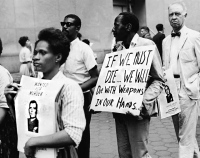To mark the 50th anniversary of the founding of Progressive Labor Party, CHALLENGE is publishing a series of articles on our Party’s history, from its origins as the Progressive Labor Movement (PLM) to its presence today in more than two dozen countries worldwide. This issue reviews one of PLP/PLM’s historic fights against racism.
In the class war to overthrow capitalism, fighting racism is a strategic necessity. When the bosses divide Black and white workers, the entire working class is denied the potential of Black workers’ leadership in the fight for armed communist revolution. In the United States, drawing from their historical super-oppression, Black workers led the battle against slavery. They have stood on the front lines in major strikes, in the fight for jobs and in other attacks on the profit system. 
Ever since the 17th century, when Black slaves were first brought to the Americas from Africa, racism has been the keystone of the U.S. capitalist system. Racism pits groups of workers against one another, diluting our class’s strength in battles against the rulers. Racism enables the bosses to use lower-paid Black and Latin workers as a wedge against white workers struggling to improve wages and working conditions. As a result, the capitalist ruling class takes greater profits from all workers while stealing super-profits—totaling hundreds of billions of dollars a year—from Black and Latin workers.
By claiming that some workers are superior to others, racism devalues human life. To continue to build our Party, and ultimately to lead a communist revolution against the capitalist class, we must put the fight against racism and for multiracial, working-class unity front and center.
Harlem Rebellion
In 1964, the young Progressive Labor Movement played a lead role in the historic Harlem Rebellion, the first Black-led urban uprising of the era against police terror. On July 16, an off-duty cop, Lieutenant Thomas Gilligan, shot and murdered James Powell, a 15-year-old, 122-pound ninth-grader, in cold blood. For six consecutive nights, the anger of the Black masses boiled over in open rebellion in central Harlem and then in Bedford-Stuyvesant in Brooklyn. Thousands of militant youth took to the streets, directing their anger at the cops and at price-gouging store owners. Molotov cocktails were hurled at shops and police cars. Thousands of cops were rushed to Harlem to quell the revolt, but it continued to spread. Thousands of gunshots were exchanged.
Mayor Robert Wagner and his police commissioner put Harlem under virtual martial law, outlawing demonstrations, rallies and marches. Civil rights misleaders tried to control the crowd by calling for “peaceful protest,” but were ignored. The phony “leftist” Communist Party USA (CPUSA) backed these reformist pleas for peace at any price. PLM was the only force to give political direction to the spontaneous rebellion.
Thousands of PLM posters declaring, “WANTED FOR MURDER, GILLIGAN THE COP!” were circulated throughout Harlem and beyond. Thousands of copies of CHALLENGE—first published a few weeks earlier—were distributed. Rebels marched in the streets with the paper’s front page as their flag.
PLM pointed out that the rebellion was also directed against Harlem’s pervasive racist conditions: an unemployment rate three times as high as the city as a whole; half the city’s average family income; three times the ratio of substandard housing; nearly twice the infant mortality rate. Black women workers were and are the most exploited section of the working class. This fight against racism was yoked to the fight against sexism. Though anti-sexist class-consciousness was not at the forefront, the Rebellion was also a fight against these sexist living and working conditions in Harlem.
Bosses Attack PL
The bosses’ media viciously attacked PL for “inciting riots.” The CPUSA called us “adventurist.” Our leaders’ lives were threatened, and they were tailed by the cops’ Red Squad 24 hours a day. Several were arrested for defying the rulers’ bans on demonstrations and for “inciting to riot,” which carried a potential sentence of 20 years in jail.
Specifically, PLM was enjoined from organizing marches between 110th Street and 155th Street for the whole width of Manhattan. We defied the ban and led a demonstration in the heart of Harlem. The Harlem PLM chapter leader was convicted and jailed for “inciting a riot,” as were the printers who made the Gilligan poster. Dozens of PL’ers and friends were subpoenaed before a grand jury and threatened with contempt citations, and several were convicted and served prison time. An international defense campaign was launched; leftist philosophers Bertrand Russell and Jean-Paul Sartre, among others, spoke out on our members’ behalf.
Although the rebellion soon subsided, our Party’s reputation stayed strong in Black communities throughout the U.S. In San Francisco, where we had been virtually unknown, nearly 500 militant Black workers and youth turned out to hear a PLM leader give an eyewitness report of the Harlem struggle. Following Harlem, more than 100 cities nationwide, not content with “cooling it,” felt the torch of rebellion.
Our role in the Harlem Rebellion is a testament to PL’s lifelong committment to fighting racism. This is part and parcel of defeating capitalism. We envision a world where the very concept of race will be abolished. We will build a communist society where all workers have the same opportunity to use all their potential to advance humanity and the planet. Join us in building the next generation of international leaders against racism.